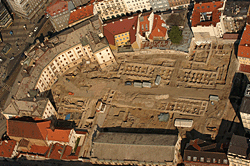Mysterious mummy lays in Geology Hall

Although now at home in the Rutgers Geology Hall, the female mummy that resides on the Old Queens campus building spent many years in a far more undignified place: one of the closets of the New Brunswick Theological Seminary.That's right, mummy.Few students here are aware of the opportunity to catch a rare glimpse into the burial ceremony of a foreign and strange culture.
Of course, other than its resting place, there is very little known about the mysterious mummy."We know it came from Northern Egypt, but that's about it," said William Selden, the collections manager of the Geology Hall.Other than that and the fact it dates to about 320 or 330 B.C., Rutgers experts are unaware of exactly where the mummy originated from, or to what family the woman belonged.
Read the full story at The Daily Targum...
http://www.dailytargum.com
/media/paper168/news/2005/10/28/
PageOne/Mysterious.Mummy.Lays.In.Geology.Hall-1037715.shtml?norewrite&sourcedomain=www.dailytargum.com




























